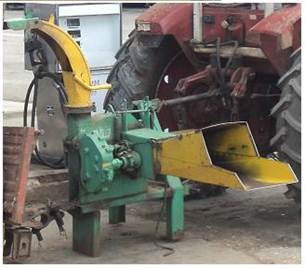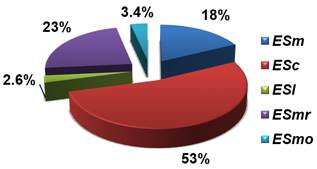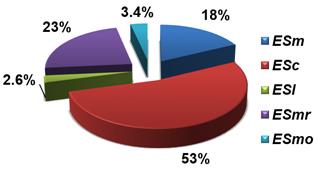INTRODUCTION
For the application of new technologies in livestock in Cuba, it is proposed to establish forage areas (mainly sugar cane and kingrass) to feed animals. That generates a high demand for mechanized technologies to process these new sources of food in dairy farms, according to Valdés et al. (2012). In addition to these crops, more recently, different protein plants have been incorporated, such as moringa, mulberry and titonia, which have had very favorable results in Cuba, Latin America and the Caribbean, according to Acosta (2017); Alonso (2017) and González (2018).
These crops must be processed, and according to the specific operating conditions of each production unit, there must be forage choppers for the important function of shredding or physical rupture, since they have a high content of fiber. That facilitates a faster digestion, contributes to a greater supply of nutrients to the ruminant and, in turn, favors higher consumption according to Elías et al. (1990) and Martín (2005), aspect to be taken into account for the acquisition of those machines.
Research concerning the estimation of the use of energy and energy costs, must be taken into account to evaluate or characterize a process. That identifies and measures the amounts of energy sequestered and incorporated into the products and equipment involved in the production of a good. It allows an increase in energy efficiency of technological process in agricultural activities. In Cuba, several authors have conducted studies in this direction. Ramos et al. (2012), determined the energy costs of the fodder crop for cattle in Cuba, evaluating Fraga model P-150 and SPKZ-160 machines. De las Cuevas et al. (2009) and (2011), made the same determinations of a direct seeding tractor-machine set and of a CEMA-1400 blade roller for vegetable cover, respectively. In addition, Valdés et al. (2016) determined energy costs of MF IIMA forage chopper, model EM-01, perfected with electric drive.
Other authors, such as Hetz and Barrios (1997), realized the reduction of the energetic cost for tillage/sowing, using conservationist systems, for the most common mechanized agricultural operations in Chile. Similarly, Olivet et al. (2014) performed the energy balance of three tillage technologies in a Vertisol for the cultivation of tobacco. Likewise, Cadena et al. (2013), stipulated the use of energy for three tillage systems (conventional, vertical and zero) and García de la Figal et al. (2012), evaluated the operation, economic and energetic expenses in the cultivation labor of beans, tomatoes and potatoes comparing YUMZ-6M tractor and oxen works.
The aforementioned studies have been directed to other types of machines and processes among which, the tractor-forage harvester set object of study, used in forage processing for the production of animal feed in Cuba, is not found.
Based on this background, this research is developed, with the aims to: Determine the energy costs of BELARUS 510 tractor and JF 50 forage chopper set, as part of the research project entitled: Development of a machine module for the production of animal food from different crops, belonging to the National Program of Animal Feed.
METHODS
The empirical investigations were carried out in the Milk Unit B of the Institute of Animal Science (ICA), Catalina de Güines, Mayabeque Province. The Belarus 510 tractor set and the JF-50 forage chopper were evaluated, with a disc type work organ, with 4 blades, stationary work position, manual feeding and tractor PTO drive (Figure 1), during the supply of fresh shredded forage from sugarcane to a group of 15 dairy cows. The experimental data were taken daily for 35 days between the months of February and March 2013, under the following weather conditions: relative humidity 72,83%, temperature 25,7 °C, rainfall index 16,76 mm, atmospheric pressure 1 015 hPa and wind speed 5,4 m/s.

FIGURE 1.
BELARUS 510-tractor and JF-50 forage chopper machine set.
Methods Used to Determine Energy Costs
The methodology used to establish the energy costs of execution of the operation was the one proposed by Bridges and Smith (1979), presented by Hetz and Barrios (1997), supported by the background presented by Fluck (1992) and ratified in 2012 by Fluck (2012). This methodology determines the total energy costs of the mechanized agricultural operation (MJ/h), adding the energy sequestered in the construction materials, including manufacturing and transportation, fuel, lubricants/filters, repairs/maintenance, and the workforce needed to operate the equipment.
The total energy costs of the mechanized agricultural operation (EST) of the tractor-forage chopper machine JF-50 set are calculated according to Equation (1):
ESm
- energy sequestered in materials, manufacturing, and transportation, MJ / h;
ESc
- energy sequestered in fuel, MJ / h;
ESl
- energy sequestered in lubricants / filters, MJ / h;
ESmr
- energy sequestered in repairs / maintenance, MJ / h;
ESMO
- energy sequestered in workforce, MJ / h;
Energy sequestered in materials, manufacturing, and transportation (ESm) was calculated using Equation (2):
Gt, Gm
- mass of the tractor and the agricultural machine, respectively, kg;
EUt, EUm
- energy per unit mass of the tractor (Table 1) and the agricultural machine, respectively, MJ / kg;
VUt, VUm
- useful life of the tractor and the agricultural machine, respectively, h.
The values for Gm in Equation (2) were obtained from experimental measurements and from catalogs of the manufacturers, the values of (EUm) were obtained from Fluck (1981), as well as from Hetz and Barrios (1997), and the values of VUt, VUm were obtained from Frank (1998), presented in Table 1
TABLE 1.
Data for calculating the energy costs of the BELARUS 510-tractor and JF-50 forage chopper set
The energy corresponding to the fuel used (ESc) was calculated with the standard proposed by ASAE, (1993), supported by Hetz and Barrios (1997), according to Equation 3:
The energy corresponding to lubricants / filters (ESl) and repairs / maintenance (ESmr) was calculated as proposed by Fluck (1985) and calculated by Hetz and Barrios (1997) as 5% of fuel energy and 129% of energy corresponding to materials, manufacture and transportation, respectively, which is expressed as follows:
The energy expenditure of the workforce (ESmo) was established as proposed by Fluck, (1981), according to Expression 6
These energy costs expressed in MJ/h were transformed to MJ/t using the productivity per hour of the machine's operating time, according to Expression 7:
ESt
- total energy costs of the mechanized agricultural operation per unit of processed mass, MJ/t;
W07
- productivity per hour of exploitation time, t/h, according to Cuevas et al., (2015).
RESULTS AND DISCUSSION
Analysis of the Results of the Energy Costs of the Set Formed by BELARUS 510 tractor and JF-50 Forage Chopper
Table 2 shows the results of energy costs of the set formed by BELARUS 510 tractor and JF-50 forage chopper, for each of the components studied.
When observing the results of the energy costs of the BELARUS 510 tractor and JF-50 forage chopper set, it can be seen the total energy costs depend, to a greater extent, on the energy sequestered in fuel (ESc) of 103,73 MJ/h and 53% as the highest value. It was followed by the energy sequestered in repairs and maintenance (ESmr), with a value of 44,92 MJ/h for a percentage of 23%. Then followed by the energy sequestered in materials, manufacturing, and transport (ESm) with a value of 34,82 MJ/h with a percentage of 18%. After that, the energy sequestered in labor (ESmo), with a value of 6,83 MJ/h, with a percentage of 3,4% and, finally, the energy sequestered in lubricants and filters (ESl), representing the lowest dependence with a value of 5,19 MJ/h and the lowest percentage with a value of 2,6%.
Valdés et al., (2016), obtained similar results for the MF IIMA forage chopper machine, model EM-01, perfected with electric drive. In that case, the total energy costs depend, to a greater extent, on the energy sequestered in electricity (ESe), with a value of 17,23 MJ/h, for the highest percentage of 64%. Therefore, the maximum value in both machines, depend fundamentally on the energy indicator used in each one specifically.
It is also appreciated that the total hourly energy costs (EST) amount to 195,48 MJ/h and the total energy costs per unit of mass processed (ESt) to 365 MJ/t.
TABLE 2.
Results of the energy costs of the Belarus 510 tractor and JF-50 forage chopper set
| Parameter | U/M | BELARUS 510 - JF-50 | %, of the total |
|---|---|---|---|
| ESm | MJ/h | 34,82 | 17,81 |
| ESc | MJ/h | 103,73 | 53,06 |
| ESl | MJ/h | 5,19 | 2,65 |
| ESmr | MJ/h | 44,92 | 22,97 |
| ESmo | MJ/h | 6,83 | 3,49 |
| EST | MJ/h | 195,48 | - |
| ESt | MJ/t | 365 | - |
Figure 1 shows the results in percent of the hourly energy costs of the BELARUS 510 tractor and JF-50 forage chopper set, for each of the energies linked to that machine. The energy sequestered in fuel (ESc) represented the highest percentage with 53%. Cuevas et al. (2011) and Ramos et al. (2012) obtained similar results. The lowest corresponded to the energy sequestered in lubricants and filters (ESl) with 2,6%.

FIGURE 1.
Energy costs of the BELARUS 510 tractor and JF-50 forage chopper set.
CONCLUSIONS
For the BELARUS 510 tractor and JF-50 forage chopper set, the total energy costs depend, to a greater extent, on the energy sequestered in fuel (ESc) with a value of 103.73 MJ/h, which represented a percentage of 53% with respect to the total cost. They depend, to a lesser extent, on the energy sequestered in lubricants and filters (ESl), with a value of 5.19 MJ/h, which represented a percentage of 2.6%.
The total hourly energy costs (ESt) of the BELARUS 510 tractor and JF-50 forage chopper set amounted to 195,48 MJ/h.
The energy costs per unit mass processed (ESt) of the BELARUS 510 tractor and JF-50 forage chopper set amounted to 365 MJ/t.










